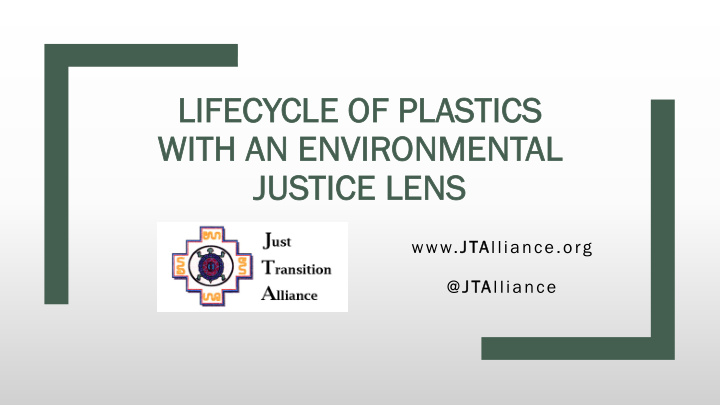



LIF IFECYCLE O OF P PLASTIC ICS WIT ITH A AN E ENVIR IRONMENTAL JUSTIC ICE L LENS www. JT JTA lliance.org @ JT JTA lliance
EXTRACTIO ION O OF O OIL IL ■ Most, if not all, of the chemicals that are used to manufacture plastics are derived from the extraction of oil and/or fossil fuels ■ Oil extraction puts many communities in harms way. But Indigenous Peoples bear a disproportionate impact given that Indigenous communities are often targeted for oil extraction, waste dumping and pipelines that carry the oil from the extraction site to the refineries and ultimately the chemical plants LIFECYCLE OF PLASTICS WITH AN ENVIRONMENTAL JUSTICE LENS
CHEMIC ICALS IN IN P PLASTIC ICS ■ In the United States most chemicals are manufactured in Communities of Color and Low Income Neighborhoods (Environmental Racism) ■ Many of the refineries and chemical plants are clustered in Environmental Justice (EJ) communities in the South, Northeast and West Coast ■ Toxic waste dumps are also more often sited in EJ communities LIFECYCLE OF PLASTICS WITH AN ENVIRONMENTAL JUSTICE LENS
WHERE P PRODUCTS A ARE M MADE ■ Environmental Justice (EJ) communities are places where polluting industries that make products from plastic are primarily located ■ These communities are commonly not afforded the same protections as white communities. One of those protections is zoning laws. Zoning in EJ communities most often includes industrial facilities and residential, daycare, schools and many other sensitive uses right next to each other. LIFECYCLE OF PLASTICS WITH AN ENVIRONMENTAL JUSTICE LENS
TRANSPORTATION IMPACTS ■ Environmental Justice (EJ) communities are usually next to major highways and rail lines and have a multitude of polluting diesel trucks and trains traveling through them ■ Chemicals, raw materials, finished products, waste/recycled materials, as well as many other dangerous things in the plastic lifecycle travel through EJ neighborhoods LIFECYCLE OF PLASTICS WITH AN ENVIRONMENTAL JUSTICE LENS
DOLLAR S STORES ■ People of Color and Low Income Communities are saturated by “Discount Retailers” a.k.a. Dollar Stores. ■ These discount retailers sell cheap products and most of them are made out of plastic. ■ These products are often full of BPA, Lead, Phthalates, PFAS, Glyphosate and many other toxic chemicals. ■ So we have exposure from plastic products and the environmental impacts in the lifecycle of those products. LIFECYCLE OF PLASTICS WITH AN ENVIRONMENTAL JUSTICE LENS
$1 $1 CONSUMERS CO ERS $ $ 1 1 ■ People of Color and people that live in low income neighborhoods more often only have discount retailers (Dollar Stores) as their only choice to purchase housewares, self-care and pre-packaged food ■ Plastics are abundant and there is no alternative ■ These same consumers cannot just buy their way out of plastics goods and the danger associated from chemicals in plastics ■ Starbucks, Whole Foods and Trader Joes are nowhere to be seen in these Environmental Justice (EJ) communities. On the other hand, if these high end retailers do site in our communities this sometimes signals the start of gentrification. LIFECYCLE OF PLASTICS WITH AN ENVIRONMENTAL JUSTICE LENS
PLASTIC IC W WASTE ■ When it comes to waste from plastics we have to include the ways that plastics are disposed of: landfills, incinerators, waste transfer stations, and recycling facilities ■ Most of facilities are in people of color and low income neighborhoods ■ We also send our plastic waste to other countries and in many cases the children that work in these facilities look just like the children here in the United States, where the plastic lifecycle begins LIFECYCLE OF PLASTICS WITH AN ENVIRONMENTAL JUSTICE LENS
PLASTIC ICS IN IN T THE O OCEAN ■ Much of the ocean’s plastic waste is dumped there from developed countries ■ There are people who depend on the ocean for their livelihoods and for subsistence fishing ■ As plastics are broken down in the oceans they become microbeads, these microbeads are now in fish and other sea life. In the Arctic we are finding the same chemicals used in plastic manufacturing thousands of miles away in the lower 48 states. These chemicals are found in fish and mammals that are traditional food sources. ■ The impact from the plastic lifecycle is impacting those that are least to blame from the indiscriminate use of plastics LIFECYCLE OF PLASTICS WITH AN ENVIRONMENTAL JUSTICE LENS
FIN INAL T THOUGHTS ■ We need to keep fossil fuels in the ground! Pe Period! This will force us to attack the problems about plastics and chemicals from a more sustainable and equitable perspective. ■ We cannot afford to look one product or one plastic stream at a time ■ Chemical manufacturers are the largest industrial consumers of energy thus linking plastic manufacturing to climate change (Climate Justice) and disproportionate health impacts in EJ communities and the global South ■ Dealing with the plastic lifecycle at its origin is a perfect scenario for a Just T Transition LIFECYCLE OF PLASTICS WITH AN ENVIRONMENTAL JUSTICE LENS
QUESTIONS & ANSWERS You c can f find t the i infographic o online on o our w website a at: j t j t a l l i a i a n c e . o e . o r g / m a te r e r i a i a l s /
THANK YOU FOR MORE INFO VISIT WWW. JT JTA LLIANCE.ORG
Recommend
More recommend